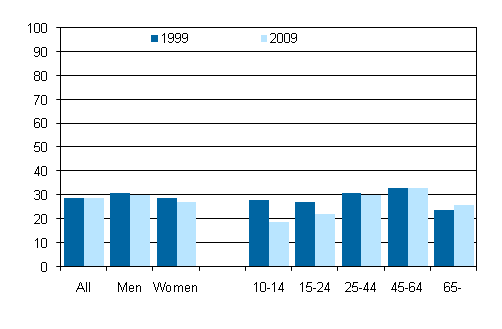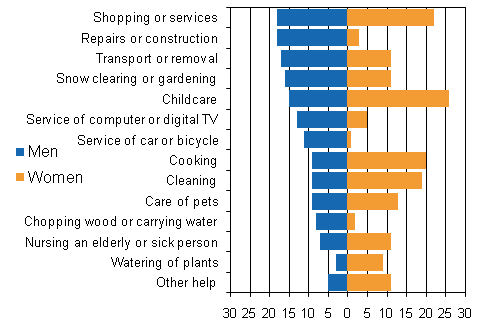Published: 16 September 2011
Participation in voluntary work unchanged in the 2000s
According to Statistics Finland's Time Use Survey, 29 per cent of the population aged 10 or over in Finland had done voluntary work in 2009. At the level of the whole population, participation in voluntary work has remained unchanged over the past decade. However, children's and young people's participation in voluntary work has diminished considerably. Most voluntary work is done in sports and athletics clubs.
Number of persons having done voluntary work in the course of four weeks by gender and age in 1999 and 2009, population aged 10 or over, %

Highly educated people do more voluntary work than people with low level of education. Doing voluntary work has increased notably among self-employed farmers. They do more voluntary work than any other socio-economic group. Other self-employed persons and upper-level employees also do a lot of voluntary work.
Men participate more than women in the voluntary work of sports and athletics clubs, residential associations, village and housing corporation committees, nature and environmental associations and diverse hobby organisations. Women, in turn, participate more than men in the voluntary work of health and social organisations, religious societies, agricultural and home economics advisory organisations, and activities of parent-teacher associations of daycare homes and schools
Helping of friends and neighbours is widespread
Fifty-nine per cent of the respondents had helped another household during the four weeks preceding the Time Use Survey. Help was most often given to friends, co-workers or neighbours. Women helped most frequently in childcare, shopping, cooking and cleaning. Men, in turn, helped in repair and construction work, transport and removals, as well as in shopping and services.
Help provided by men and women during four weeks in 2009, population aged 10 or over, %

In the four weeks preceding the Survey, nearly one-half of the respondents had received help from a friend, relative or neighbour in work connected with their household. Most help was received by persons looking after their own household and the majority of the help was received in childcare. The households of highly educated persons received more help than the households of persons with low education.
Employed and unemployed households received help almost equally often, but the households of unemployed persons received less help than the households of employed persons. The households of pensioners and chronically ill persons received less help than all households on the average.
Source: Time Use Survey 2009, Statistics Finland
Inquiries: Riitta Hanifi (09) 1734 2946, Hannu Pääkkönen (09) 1734 3229, ajankaytto@stat.fi
Director in charge: Riitta Harala
- Tables
-
Tables in databases
Pick the data you need into tables, view the data as graphs, or download the data for your use.
Updated 16.9.2011
Official Statistics of Finland (OSF):
Time use [e-publication].
Participation and volunteer work 2009. Helsinki: Statistics Finland [referred: 20.4.2025].
Access method: http://stat.fi/til/akay/2009/04/akay_2009_04_2011-09-16_tie_001_en.html

